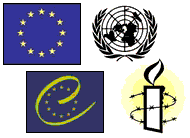The European Convention on Human Rights
Created | Updated Jan 28, 2002

The European Convention on Human Rights, otherwise known as the Convention for the Protection of Human Rights and Fundamental Freedoms, is a convention that was passed by the Council of Europe1 in 1950 in response to the Universal Declaration of Human Rights which was drawn up by the United Nations (UN) in 1948. The aim of the convention is to give people who live in European states a list of civil and political rights which the member states of the Council of Europe believed every person in Europe should expect to have.
Basic Rights and Freedoms under the Convention
The following basic rights and freedoms are set down in the Convention:
- The right to life
- The right to liberty and security
- The right to fair trial
- The right to no punishment without law
- The right to respect private and family life
- The right to marry
- The right to a remedy of human rights abuses
- Freedom of thought, conscience and religion
- Freedom of expression
- Freedom of assembly and association
- Prohibition of torture
- Prohibition of slavery and forced labour
- Prohibition of discrimination
- Prohibition of the abuse of rights
The convention allows exceptions in some circumstances which are laid out clearly in the articles for each right. For example, a person has a right to life unless they are killed by self-defence; while resisting arrest or trying to escape while lawfully detained; in lawful police riot control action; or as a punishment laid down by a court for a suitable crime.
The Full Convention lists all exceptions and circumstances.
The European Commission of Human Rights
The Commission of Human Rights was founded under the Convention. The role of the Commission is to investigate claims of human rights abuses, made either by states or individuals. Once investigations have been carried out the findings are passed onto the European Court of Human Rights, who have the compulsory jurisdiction, recognised by many states, to try individuals or governments for Human Rights abuses. For example, the court has forced the Republic of Ireland to withdraw its law banning homosexual activity.
Other Human Rights Organisations
Other agencies which try to stop human rights abuses include Amnesty International and the United Nations.
Amnesty International
Amnesty International was founded in 1961 in the UK and its main goal is to campaign for the release of political prisoners the world over. The agency has helped hundreds of political prisoners to become free and it was awarded the Nobel Peace Prize in 1977.
The United Nations
The United Nations is the international organisation which passed the Universal Declaration of Human Rights. It comprises of many sub-organisations which act as watchdogs and providers of aid (medical, financial and military, specifically) to all of the world where they are needed. The UN has representatives from almost every country in the world as members. On specific Human Rights issues, the UN High Commissioner for Human Rights investigates claims made by individuals or states, much in the same way that the European Commission on Human Rights does.

